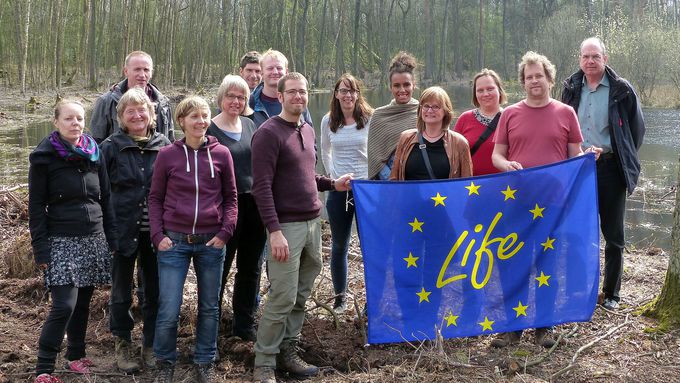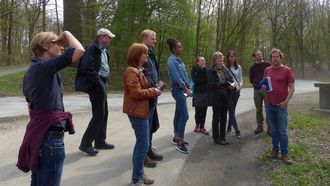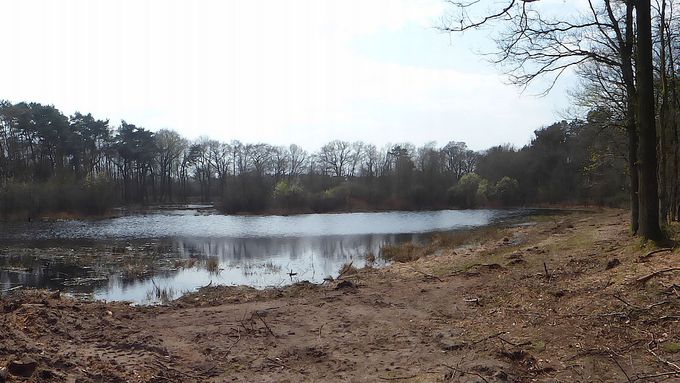The LIFE IP team visiting the action ‘Hanfteich’, Hartmut Storch from the Biological Station of the District of Steinfurt is to the left in the back row © Annika Brinkert
download picturemain content
Project of the month
#4/2018 REGULAR EXCHANGE OF INFORMATION AND CONTINUOUS PROJECT CONTROL
Monitoring Visits of the European Commission
Each Integrated LIFE Project, funded by the European Union's LIFE funding programme, receives a visit from an external monitoring team twice a year. In the current phase of the LIFE programme, the EU Commission assigned this function to the NEEMO EEIG. The Freiburg-based German NEEMO partner, Particip GmbH, is responsible for the member states Germany and Austria. In addition to regular monitoring of the technical and financial progress of the LIFE projects, the evaluation of the qualitative performance as well as the continuous evaluation of the efficiency in the achievement of the objectives are tasks of the respective responsible persons. In addition, NEEMO is advisory and supportive for the LIFE projects and is the first contact for fundamental questions or problems in the implementation of the projects.
Ruth Brauner and Lars Borrass from Particip and Jan Vančura from Ernst & Young are responsible for the Integrated LIFE Project "Atlantic Region DE". By now, three project visits were carried out. In 2017, the two meetings took place at the end of April in the North Rhine-Westphalian Ministry of the Environment in Düsseldorf and in mid-October in the Ministry of the Environment of Lower Saxony in Hanover. On the second day of the latter, two actions in the City of Celle were visited on site: the ‘Henneckenmoor’ (action C70) and the pond area ‘Entenfang-Boye’ (actions C94-C96).
The most recent NEEMO monitoring visit on 10th and 11th April 2018 at the District Government of Münster again comprised a thorough review of the actions that have already been completed or are still being implemented, the project and the financial documentation, and the public relations work that has been carried out so far. The planning of actions for the second project phase from 1st April 2019 as well as the transition from the first to the second phase were also discussed.
On the second day, starting at noon, the participants went outdoors into the district of Steinfurt. A stopover took place at the Ems construction site for the reactivation of the Ems cut-off at Hembergen. This action, which is carried out by the Department 54 of the District Government of Münster and serves as a complementary action to the LIFE IP, aims at e.g. the development of near-natural pond water habitats and the ecological optimization of the Special Area of Conservation “Emsaue” between Hembergen and Saerbeck. Subsequently, two actions which had been already started and supervised by the Biological Station of the District of Steinfurt were visited. In the SAC ‘Hanfteich’ (action C4), the oldest nature reserve within the district of Steinfurt, the bank areas of the heath pond and the adjoining small waterbody had been cleared from wood in the preceding months in order to optimize the habitat of the LIFE IP focus species – floating water-plantain (Luronium natans), crested newt (Triturus cristatus), and moor frog (Rana arvalis) – and to improve the conservation status of the habitat type ‘oligotrophic to mesotrophic standing waters with vegetation of the Littorelletea uniflorae and/or of the Isoeto-Nanojuncetea’ (3130). As a further action site, the ‘Heide an der Hohen Haar’ in the ‘Veltruper Feld’ north of Saerbeck and Emsdetten was visited. The area is located in a dune chain forested with pine forest, pine mixed forest and birch oak forest. On the area owned by the district there are three smaller nutrient-poor standing waters. Particularly noteworthy is the occurrence of the floating water-plantain (Luronium natans) as well as marsh St. John's wort (Hypericum elodes), creeping willow (Salix repens), marsh clubmoss (Lycopodiella inundata) and long-leaved sundew (Drosera intermedia). The heath pond in the centre had been shadowed by trees and eutrophicated by the falling leaf and needle litter. The standing waters further east had previously been densely surrounded by pine young-growth forest and highly shaded. In the preceding months, therefore, the trees on the bank areas of the two heath ponds had been completely removed. In both areas, in a second step in the coming late summer/ autumn, the eutrophicated bank areas will be desludged.
The NEEMO monitoring team was visibly satisfied with the overall project progress so far and the developments in the sites of action which were presented. In the next monitoring visit – probably at the beginning of November in Dusseldorf – the final design of the amendment and supplementary application for the second project phase will be a thematic focus.






